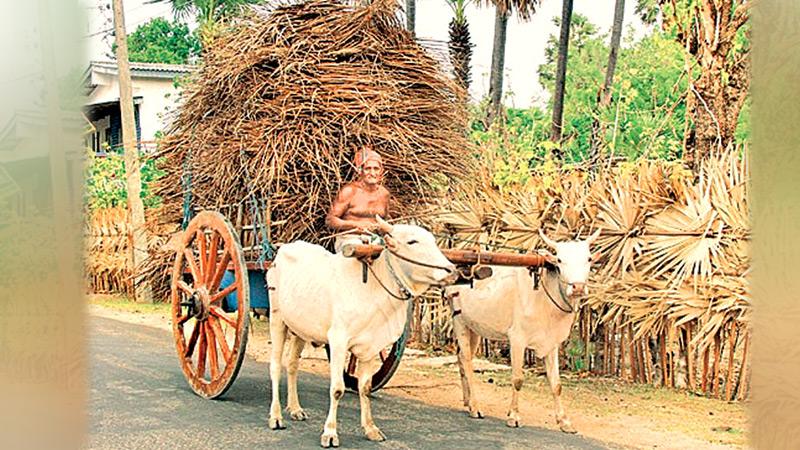
One of the beautiful memories of childhood was the sight of a bullock cart, trundling down the road. The carter wore a turban like cloth to beat the sun. His teeth were stained red by chewing betel. The robust bulls came in various shades of brown, black and white. As the cart moved down the road dogs began barking. In those bygone years the cart carried king coconuts. A suspended sack attached with string, below the cart held grass for the bull to snack when resting.
Wheels of fortune
The use of the bulls for conveyance has been rooted in Sri Lankan culture for centuries. The carter was an important person in the village. Our ancient records show that carts moved in convoys, travelling up to a week taking provisions from the village to the city. These humble carters made a significant contribution to trading in vintage Ceylon. They moved our tea, coffee, rubber and spices before the advent of railways. Many businessmen in that era accumulated wealth by hiring these ‘cart caravans.’ These carts were ‘chartered’ by village folk for religious pilgrimage. Using the carts devotees travelled to distant shrines – Madhu Church, St. Anne’s Church, Talawila, Kataragama Devale and Muneshwaram Kovil in Chilaw. Bullock carts also carried bricks and other material which were used to build temples, kovils, mosques and churches and houses. Postal service records mention ox carts being used to take parcel post in the early days. Another fancy use for the cart was in advertising films. Cardboard cut outs of film stars were tied to the cart with the name of the theatre and show times. The cart would travel around villages bordering the main city. A few years ago I met one such carter in the Ramboda area. The old man said “When my cart enters the village, young boys and girls would gather round. Children would be dazzled by the cutouts of the film stars .” In many rural areas until the last 25 years bullock carts were used for travel, even taking patients to hospital.
Horses too were used for transport, by the wealthy and the powerful. There were horse drawn carts, but their number was far less compared to the common bullock carts.
Mechanized competition
Colonial Ceylon was gradually transformed. Cars and lorries took to the roads. The railway steadily spread her lines towards major cities, and transporting of goods by train became the choice. Unlike carts trains ran to schedule in sunshine or rain. Slowly but surely the bullock cart was relegated to transport duties restricted within the villages and the estates. The affluent mansions maintained one cart (hackery with seats) where the village headmen rode with pomp and decorum. With the influence of western culture, there arose a social division between working classes. As people entered the clerical service the humble carter was further relegated to the past. The once dependable carter and his bulls were now isolated. Not having daily work the carter struggled to feed the animal and his own family. As motor cycles became popular in rural areas and small cars became affordable the bullock cart was sentenced to extinction.
Last of the carters
Until the recent past there was a solitary carter in the Colombo city. Chandana navigating his red cart, was a visual relished by the city folk. A resident of Maradana, he was engaged in selling kerosene oil for many years. In writing this narrative I drove around Colombo for two days with a friend, trying to find this carter. He seemed to have eluded me. Apart from this I have not seen a bullock cart in Colombo. On my travels around the country I have witnessed a few carts in Jaffna, Matara, Dambulla and Trincomalee. I have previously written about the last blacksmith in the village of Moolai (Jaffna) who makes bullock carts with his brother. In the Northern village of Kottaikaddu live the last remaining clan who engage in cart races. This clan takes pride in their white ‘Vaddakan’ bulls. Some carts are operated in Habarana and Sigiriya giving rides to tourists. One of these young men told me “I do this on a part time basis. I drive a three wheeler. We don’t know to make carts. It’s costly to feed the bulls. We do this just for fun”.
Lost in motion
The art of making carts is dead, except for a handful of old craftsmen concealed in distant villages. This ancient craft was once appreciated by kings. The thirikkalle was single seater and the load hauling cart was called barabage. The wood used for building was domba, halmilla and burutha. The process per cart took nearly a month. The rack was a standard size, 6 feet long and 3 feet wide. The covered canopy was an additional choice. Fixing the garadi- wooden spokes, to the wheel was the crucial task. The completed cart was handed over to the owner after religious incantations. We encounter change daily in every sphere of life. The carters of Ceylon have wheeled into the sunset, leaving behind nostalgic memories.
